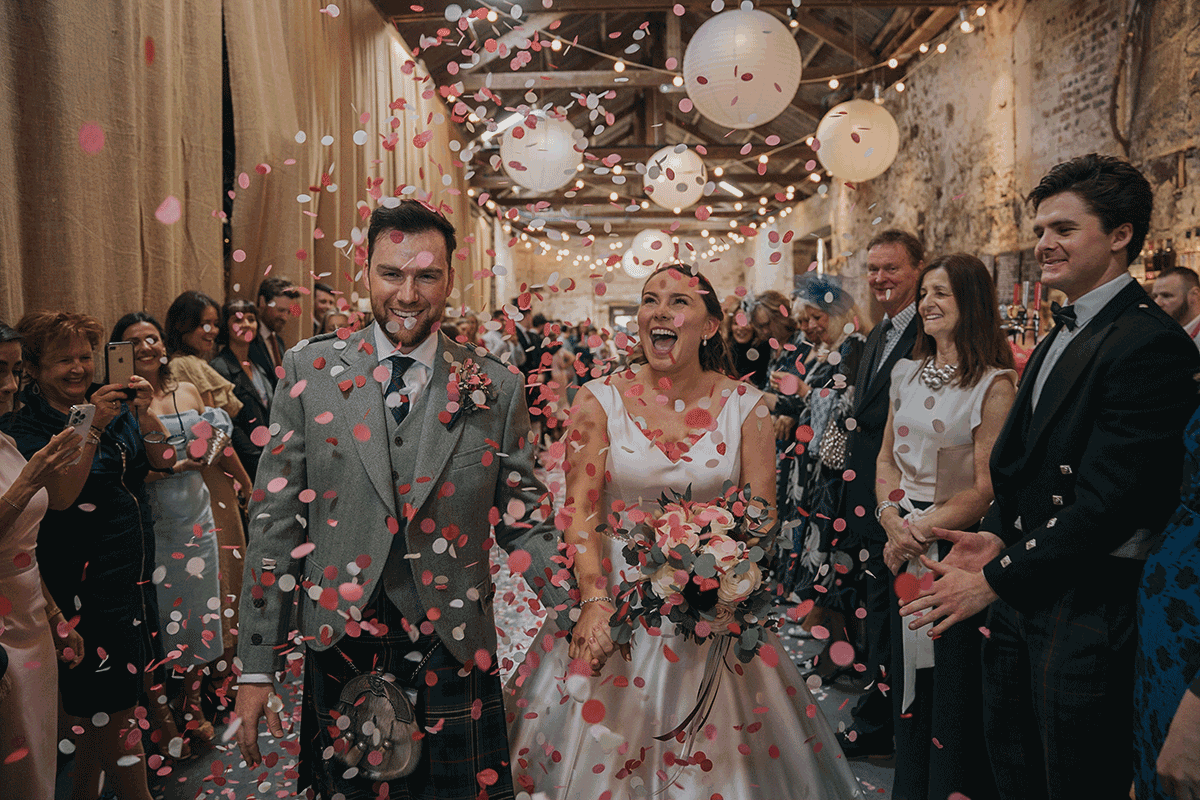Not sure which wedding traditions you’re expected to follow in Scotland? From vows and speeches to timelines and cakes, here’s how modern couples are reshaping classic customs

Content creator Erin McBride of Your Day Unplugged brought party vibes and thrilling entertainment to her own wedding at The Engine Works (Photo: The McHendrys)
Planning a Scottish wedding and wondering which traditions you ‘have’ to follow? The short answer: none. Today’s couples are choosing celebrations that feel personal, meaningful and completely their own. Here are 11 popular wedding traditions to keep, skip or modernise to suit your day.
1. Sleeping separately the night before
The idea that couples shouldn’t see each other the night before the wedding harks back to when most people lived at home until marriage. If anyone still follows this, it’s usually for the anticipation – or for a fun bridal sleepover with friends. If staying together feels more natural, do it. There’s no ‘bad luck’ attached, just personal preference.
2. Tossing the bouquet
Scottish brides are increasingly skipping this tradition. With bouquets now costing hundreds of pounds – and preservation becoming more popular – many prefer to keep theirs intact. If you love the moment, consider tossing a smaller, dedicated bouquet instead.

(Photo: By Rhea)
3. Assigned seating by family side
Historically, one side of the ceremony was for the bride’s family and the other for the groom’s. Modern weddings in Scotland are far more relaxed. Most couples now opt for open seating with signs like “Pick a seat, not a side,” encouraging everyone to mingle and feel welcome.
4. Traditional wedding cake
The classic fruitcake is no longer a must-have. Many Scottish couples are embracing cakes that reflect their tastes: chocolate, red velvet, biscoff, or even show-stopping cheese towers. Go with whatever fits your celebration – tiered, minimal, rustic or not at all.
5. Oversized guest lists
With more couples footing the bill for their wedding, big guest lists are no longer an expectation. Instead of inviting distant acquaintances or your parents’ friends, today’s trend leans toward intentional, meaningful guest lists – whether that’s 20 guests or 200.

This American couple kept things fun at Cluny Castle in Aberdeenshire by getting all their guests to join them in a massive game of hide and seek the night before the wedding (Photo: By Rhea)
6. Traditional speech line-up
Traditionally, speeches were made by the groom, the best man and the father of the bride. Modern Scottish weddings are far more inclusive. Brides, mums, maids of honour and mixed-gender wedding parties are all stepping up to the mic. Whoever has something heartfelt to say should absolutely be included.
7. Matching bridesmaid dresses
Gone are the days of identical dresses for every bridesmaid. The mismatched bridesmaid trend is thriving across Scotland, allowing each person to choose a style that flatters them while keeping to a shared colour palette. It’s more comfortable, more stylish and reduces dress-shopping stress.

These gorgeous bridesmaids dresses, for a wedding at Achnagairn Castle, look similar at first glance but are all subtly different to suit the wearer – a perfect demonstration of just how good the 'mismatched dress' trend can look (Photo: Sun and Beau)
8. Formal ceremonies
With the rise of humanist and celebrant-led ceremonies in Scotland, personal vows and storytelling-rich scripts are becoming the norm. You can incorporate readings, symbolic rituals, humour, music and anything else that showcases who you are as a couple.
9. Traditional timelines
A ceremony at 1pm followed by dinner and dancing until midnight is still popular, but it’s not the only option. Twilight weddings – which often begin around 4pm and focus on a relaxed, party atmosphere – are increasingly popular with Scottish couples who prefer fewer formalities and more dancing.
10. No pets allowed
If your venue allows animals and your pet has the right temperament, there’s no reason they can’t join your Scottish wedding celebration. Many venues now welcome dogs for outdoor ceremonies or photography, but always check policies in advance.

Couples are increasingly involving their pets in their big day – they can serve as a ring-bearer or flowergirl, or even accompany the bride and groom down the aisle! (Photo: Dani Rose Photography)
11. Being ‘given away’
Walking down the aisle is a personal moment – and it doesn’t need to follow tradition. Some brides choose to walk with both parents, a close friend, a sibling or even solo. Others walk in together as a couple. There’s no right or wrong way – just what feels authentic to you.
FAQs about modern wedding traditions in Scotland
No — modern Scottish weddings are highly flexible. Couples are free to personalise every element, from the ceremony and processional to speeches, timelines, décor and entertainment. Traditions can be followed, adapted or skipped entirely.
Not at all. The “bad luck” idea is outdated. Most Scottish couples now choose whatever feels comfortable, whether that means staying together the night before or sharing a first-look moment before the ceremony.
Yes. Humanist and celebrant-led weddings are fully legal in Scotland and allow for bespoke vows, personalised readings and meaningful rituals. Religious and civil ceremonies may have specific wording requirements, but additional personal vows are usually allowed.
No. Couples are choosing cakes that reflect their tastes — from chocolate and red velvet to modern single-tier designs or cheese towers. Some skip the cake entirely in favour of dessert tables or doughnut walls.
Absolutely. Guest lists are entirely your decision. Many Scottish couples now choose small weddings or micro weddings for budget reasons, personal preference or a more intimate atmosphere.




